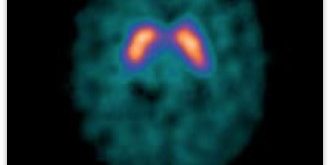A dopamine transporter study is a nuclear medicine scan which images the dopamine transporter in the brain and is used in the diagnosis of Parkinson’s disease and Dementia with Lewy Bodies. It uses the radiopharmaceutical I123-Ioflupane commonly referred to by the trade name DaTSCANTM.
Parkinson’s Disease
Parkinson’s disease affects one in 500 people, mostly over the age of 50, but younger people can get it too. The main symptoms of Parkinson’s are tremor, rigidity and slowness of movement and the diagnosis is usually made clinically. Traditional CT and MRI scans of the brain are not able to distinguish Parkinson’s disease and related disorders from other conditions with similar symptoms. Often, the initial symptoms of the disease are vague, making diagnosis extremely challenging. This can lead to delays in diagnosis and treatment.
Patients with Parkinson’s Disease typically begin to experience symptoms after losing 80 percent of the dopamine in their basal ganglia, the region of the brain involved in motor control and movement. The dopamine transporter scan assists doctors in differentiating between movement disorders that share similar symptoms, such as benign essential tremor. The scan is able to detect the early neuronal degeneration which can occur in Parkinson’s disease and can clinically reclassify the diagnosis in 10-30% of patients.
NICE guidelines recommend using DaTSCAN in patients with tremor where it is not possible to clinically differentiate Parkinson’s disease from benign essential tremor.
Whilst a dopamine transporter scan can differentiate Parkinson’s disease from benign essential tremor, the scan can also be positive in a number of variants of Parkinson’s. These are referred to as Parkinson’s plus syndromes and include multiple system atrophy, progressive supranuclear palsy and corticobasal degeneration.
Dementia with Lewy Bodies
Dementia with Lewy Bodies is a type of dementia that shares symptoms with both Alzheimer’s disease and Parkinson’s disease. It may account for around 10 per cent of all cases of dementia but tends to be underdiagnosed. Lewy Bodies are tiny deposits of protein in the nerve cells of the brain. Their presence is linked to low levels of dopamine and a loss of connections between cells.
The symptoms a person experiences will depend partly on where the Lewy bodies are in the brain. Lewy bodies in the striata are closely linked to problems with movement. These are the main feature of Parkinson’s disease. Lewy bodies in the outer layers of the brain are linked to problems with mental abilities (cognitive symptoms), which are characteristic of Dementia with Lewy Bodies.
Symptoms in Dementia with Lewy Bodies include problems with attention and alertness which fluctuate over the course of the day. Visual hallucinations are also common and can be very distressing. Up to two thirds of people with Dementia with Lewy Bodies have movement problems. These symptoms are those of Parkinson’s disease, and include slowness and rigidity of movement with a blank facial expression.
A dopamine transporter scan can:
• Provide an early diagnosis of Dementia with Lewy Bodies
• Prevent exposure to medications that may aggrevate symptoms or cause severe reactions.
• Identify commonly occurring and treatable disorders (such as REM sleep behaviour disorder).
NICE guidelines recommend using DaTSCAN to establish the diagnosis in those with suspected Dementia with Lewy Bodies if the diagnosis is in doubt.
How does a dopamine transporter scan work?
The radiopharmaceutical, or tracer, which is used is I123-Ioflupane. It is injected into the vein after administering a thyroid blocking agent in the form of oral potassium iodide. This is to prevent unnecessary accumulation of the radiopharmaceutical in the thyroid gland.
The radioactive tracer binds to the presynaptic dopamine transporters in the brain, in particular the striatal region of the brain. In Parkinson’s disease and Dementia with Lewy Bodies there is a marked reduction in dopaminergic neurons in the striatal region. The tracer binds to the dopamine transporters and gives a semi-quantitative measure and spatial distribution of the transporters.

The scan itself is a single photon emission computed tomography (SPECT) scan of the brain. The patient lies down on the examination couch with their head positioned in the headrest. Often a gentle head restraint is used to minimise motion. The gamma camera rotates around the patient’s head for approximately 30-45 minutes. During this time, it is important that the patient lies still as a three-dimensional image of the distribution of the dopamine receptors in the brain is being created.
Most patients will tolerate the scan very well, and we are used to performing the scans in patients with a tremor. In patients with suspected dementia, it is very useful to liaise with a carer to make sure the patient can attend the appointment. It is also reassuring for the patient to have their carer next to them during the scan.
The scan needs to be reported by a specialist radiologist who has experience in dopamine transporter studies. Often quantification of the tracer uptake in the basal ganglia can be helpful. There are several software manufacturers which provide a database of normal scans, which the patient’s study is compared against in order to determine whether the scan is abnormal or not. This quantification and comparison with a validated normal database can be very helpful in difficult cases.
#datscan #SPECT #neurology #nuclearmedicine #parkinsons #lewybody #dementia






